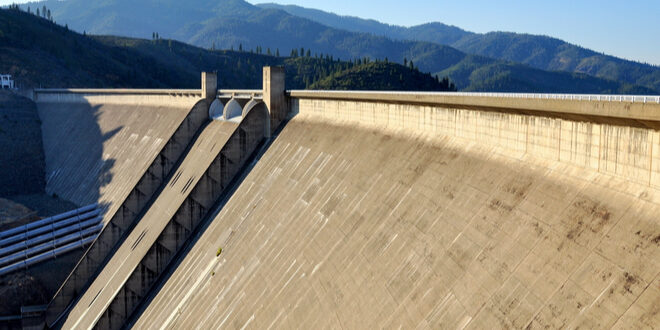Reclamation announced that spring-time operations at Shasta Dam will be adjusted to benefit endangered winter-run Chinook salmon in the Sacramento River during this critically dry water year. The operation change is coordinated with the National Oceanic Atmospheric Administration Fisheries, Western Area Power Administration, State Water Resources Control Board, and Sacramento River Settlement Contactors to preserve the limited supply of cold-water pool in Shasta Reservoir. No additional water from Shasta Reservoir will be released during this temporary adjustment—only the withdrawal elevation and timing of water releases will change.
The operation adjustment will require the bypass of Shasta Dam’s powerplant and temperature control device due to the low water elevation in Shasta Reservoir. Beginning April 18, Reclamation will instead release water from the warmer, upper layers of Shasta Reservoir directly through the dam’s river outlets into the Sacramento River. This warmer water, averaging 55 degrees Fahrenheit this time of year, will help maintain Sacramento River flows through the spring and preserve the limited supply of colder water for later in the summer when most critical for endangered winter-run Chinook. Reclamation maintains water temperatures in the Sacramento River for the protection of fishery resources.
“The only remaining population of winter-run Chinook salmon in the Central Valley is in the Sacramento River downstream of Shasta Dam,— said Dr. David Mooney, Reclamation’s Bay-Delta Office manager. “Last year, despite dry conditions, we effectively shaped cold water for higher survival rates, but other factors reduced survival to very low levels. Protecting egg incubation in this second year will help support this endangered species for the future.”
As the bypass water temperature increases later in the spring, Reclamation will revert to use of the powerplant and temperature control device when winter-run Chinook salmon spawn and colder waters are needed to protect redds. If fisheries conditions show adverse effects from a warmer spring, Reclamation will coordinate with partners to further adjust temperatures during the bypass.
The bypass of Shasta Dam’s powerplant means that hydropower will not be produced with these water releases and will have a financial impact to Central Valley Project power customers and their planned requirements to meet the state’s clean energy goals. The hydropower generated at Shasta Dam’s powerplant provides power for approximately 250,000 California households per day. Reclamation is working with the Western Area Power Administration to develop solutions to lessen the impacts to those power customers.
“This operation adjustment is part of a suite of tools Reclamation is deploying with our partner agencies and stakeholders during this critically dry year,” said Reclamation Regional Director Ernest Conant. “Reclamation appreciates the flexibility and coordination with our fellow agencies and partners on this operation adjustment to give winter-run Chinook the best chance of survival. We know we are going to have a difficult water year ahead of us, but we learned much during the last drought and are applying those lessons learned to our operations this year.”
 California Water News Daily Your Source For Water News in California
California Water News Daily Your Source For Water News in California


